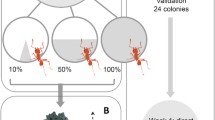Summary
We investigated the effects of thorns and spines on the feeding of 5 herbivore species in arid Australia. The herbivores were the rabbit (Oryctolagus cuniculus), euro kangaroo (Macropus robustus), red kangaroo (Macropus rufus), sheep (Ovis aries), and cattle (Bos taurus). Five woody plants without spines or thorns and 6 woody plants with thorns were included in the study. The spines and thorns were not found to affect the herbivores' rates of feeding (items ingested/min), but they did reduce the herbivores' rates of biomass ingestion (g-dry/item). The reduction in biomass ingested occurred in two ways: at a given diameter, twigs with spines and thorns had less mass than undefended plants, and the herbivores consumed twigs with smaller diameters on plants with spines and thorns. The relative importance of the two ways that twigs with spines and thorns provided less biomass varied with herbivore body mass. Reduced twig mass was more important for small herbivores, while large herbivores selected smaller diameters. The effectiveness of spines and thorns as anti-herbivore defenses did not vary with the evolutionary history of the herbivores (i.e. native vs. introduced). Spines and thorns mainly affected the herbivores' selection of maximum twig sizes (reducing diameter and mass), but the minimum twig sizes selected were also reduced.
Similar content being viewed by others
References
Belovsky GE (1981) Food plant selection by a generalist herbivore: the moose. Ecology 62:1020–1030
Belovsky GE (1984a) Snowshoe hare optimal foraging and its implications for population dynamics. Theor Pop Biol 25:235–264
Belovsky GE (1984b) Summer diet optimization by beaver. Am Midl Nat 111:209–222
Belovsky GE (1986) Generalist herbivore foraging and its role in competitive interactions. Am Zool 26:51–69
Belovsky GE, Schmitz OJ (1991) Mammalian herbivore optimal foraging and the role of plant defenses. In Palo RT, Robbins CT (eds) Plant Defenses Against Mammalian Herbivores. CRC Press, Boca Raton, pp 1–28
Cooper SM, Owen-Smith N (1986) Effects of plant spinescence on large mammalian herbivores. Oecologia 68:446–455
Croft DB (1981a) Behaviour of red kangaroos, Macropus rufus (Desmarest, 1822), in northwestern New South Wales, Australia. Aust Mammal 4:5–68
Croft DB (1981b) Social behaviour of the euro, Macropus robustus (Gould), in the Australian arid zone. Aust Wildl Res 8:13–49
Dawson TJ, Denny MJS, Russell EM, Ellis B (1975) Water usage and diet preferences of free-ranging kangaroos, sheep and feral goats in the Australian arid zone during summer. J Zool (Lond) 177:1–23
Dunham KM (1980) The feeding behaviour of a tame impala Aepyceros melampus. Afr J Ecol 18:253–257
Guggisberg CAW (1966) S.O.S. Rhino. Andre Deutsch, London
Hope J (1982) Late Cenozoic vertebrate faunas and the development of aridity in Australia. In Barker WR, Greenslade PJM (eds) Evolution of the Flora and Fauna of Arid Australia. Peacock Publications, Frewville, South Australia, pp 85–100
Lindroth RL (1989) Mammalian herbivore-plant interactions. In Abrahamson WD (ed) Plant-Animal Interactions. McGraw-Hill, New York, pp 163–206
Myers JH, Bazely D (in press) Thorns, spines, prickles and hairs: are they stimulated by herbivory and do they deter herbivores? In Tallamy D, Raup M (eds) Herbivore Induced Phytochemical Changes in Plants. Wiley Inter-Science, New York
Pellew RA (1984) Food consumption and energy budgets of giraffe. J Appl Ecol 21:141–159
Schmitz OJ (1989) Environmental variability and optimal foraging behavior of a generalist herbivore: the white-tailed deer. Ph. D. Diss, Univ Mich, Ann Arbor
Terry RA, Tilley JMA (1964) The digestibility of the leaves and stems of perennial ryegrass, cocksfoot, timothy, tall fescue, lucerne and sainfoin, as measured by an in vitro procedure. J Brit Grassl Soc 19:363–372
Wilkinson L (1990) SYSTAT: The System for Statistics. SYSTAT, Inc., Evanston, IL
Author information
Authors and Affiliations
Rights and permissions
About this article
Cite this article
Belovsky, G.E., Schmitz, O.J., Slade, J.B. et al. Effects of spines and thorns on Australian arid zone herbivores of different body masses. Oecologia 88, 521–528 (1991). https://doi.org/10.1007/BF00317715
Received:
Accepted:
Issue Date:
DOI: https://doi.org/10.1007/BF00317715




